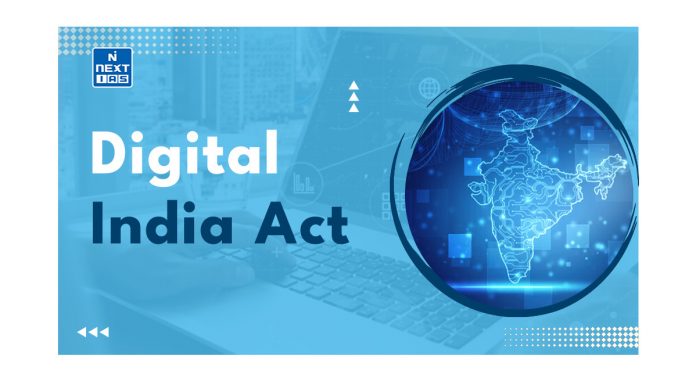Explore the significant developments surrounding the Digital India Act (DIA) of 2023, its implications on internet regulation, and the challenges and prospects it presents for India’s digital future.
Why in the News?
On March 9, 2023, Minister Rajeev Chandrasekhar unveiled the upcoming Digital India Act (DIA) as a replacement for the Information Technology Act of 2000 (IT Act). The DIA’s framework was detailed during the presentation, and MEITY is seeking input from stakeholders through ongoing consultations, sparking debates on internet regulation.
What is the Need for the Digital India Act 2023?
- Need for updated law: The Information Technology Act of 2000 is now 22 years old and was originally established during the early days of the Internet. It was designed to address the needs of the nascent IT ecosystem in 2000, a time before the advent of modern internet-based services such as e-commerce and social media platforms.
- Limited Mandate of the Law: The Act had a limited mandate, primarily focusing on the legal recognition of electronic records, transactions, and electronic signatures conducted over electronic media.
- Proliferation of E-commerce and Online Content: The expansion of e-commerce, digital transactions, and the sharing of online content necessitates the need for modernized regulations.
- New challenges in today’s times: In the present day the internet and the new information technology have empowered citizens but this also comes with various challenges as follows:
- User harm
- Ambiguity in user rights
- Security concerns
- Safeguarding the safety of women and children online
- Organized information warfare, radicalization, the spread of hate speech, the proliferation of misinformation and fake news, and unfair trade practices have emerged as pressing concerns.
What is the Status of Internet Usage in India?
India has seen impressive growth in the expansion of internet users in India. The number of internet users has expanded from 5.5 million in 2000 to 850 million internet users in 2023. The reasons for this are the increasing digitalization and rising connectivity in the country.
This growth can be attributed to various factors, including the following:
- Affordable Smartphones and Data Plans.
- Government Digital Initiatives.
- Rise in E-commerce and Digital Services.
- Digital Education and Infrastructure
What is the Digital Rights Act in India?
Key Components :
The Digital India Act (DIA) incorporates a range of crucial clauses that reflect the dynamic transformation of the digital landscape, effectively dealing with its many challenges and prospects. These provisions highlight the law’s adaptability to the continuously evolving digital environment.
- Online safety and trust: The Digital India Act places significant importance on online safety and trust, with a dedication to protect the rights of citizens in the digital sphere. The elements are:
- Choice
- Competition
- Online diversity
- Fair market access, and
- Ease of Doing Business and Ease of Compliance for Startups
- Aligns with other laws: The Digital India Act will collaborate with other relevant data related laws and policies, encompassing the Digital Personal Data Protection Act, Digital India Act Rules, National Data Governance Policy, and revisions to the Indian Penal Code related to cybercrimes.
- Flexibility: The Digital India Act aims to accommodate changing market dynamics and international legal standards, thus imbibing the flexibility in the legislation.
- Concern for new technologies: The Digital India Act aims to balance innovation on the new technologies front and also aims to regulate them. The DIA offers directives for the conscientious utilization of new technologies like blockchain, AI, etc. It advocates for ethical practices in the realm of artificial intelligence, upholds data privacy in blockchain applications, and establishes
- Adjudicatory Mechanism: The Digital India Act provides for a specialized and dedicated adjudicatory mechanism for online civil and criminal offences.
- Open Internet: The Digital India Act aims to strike a fine balance between accessibility and regulatory measures to make the Internet organized and safe.
- Review of the “safe harbor” principle: The ‘safe harbour’ principle” is a legal concept that provides protection or immunity from liability under specific circumstances. The bill aims to enforce accountability standards to cater to the complexities of the digital age.
- Know Your Customer (KYC) requirements for wearable devices.
What are the Challenges in the Implementation of the Digital India Act (DIA)?
- Impact on innovation and the ease of doing business because of strict regulation
Stringent regulations, especially in the context of emerging technologies, have the potential to unintentionally hamper entrepreneurial endeavors and discourage foreign investments.
- Review of “Safe Harbour” principle: This step can result in a more cautious approach among the online platforms. It has the potential to impinge their freedom of expression.
- Operational and Enforcement Challenges: The enforcement of the legislation requires effective enforcement. This will require use of substantial resources, expertise, and infrastructure.
- Balancing the interests of tech companies and citizens: Balancing the diverse interests of stakeholders, including tech giants, while simultaneously safeguarding the rights of citizens, presents a substantial challenge.
Way Forward
The Digital India Act (DIA) marks a pivotal stride in securing a future for India that is both safe and innovative within the digital realm. It embodies a progressive regulatory approach for a constantly evolving era, with the potential to influence India’s digital landscape for generations to come. As discussions and consultations persist, it will be fascinating to observe the progression and impact of this proposed legislation within the dynamic digital landscape.
Sources:









